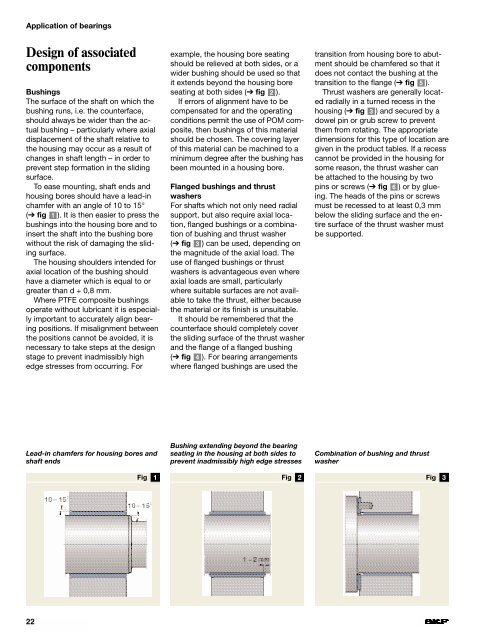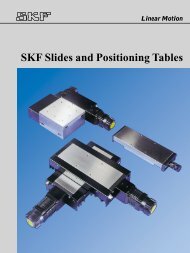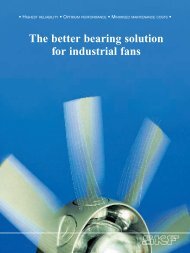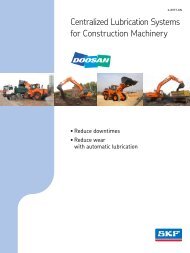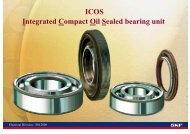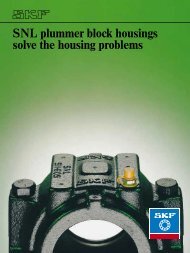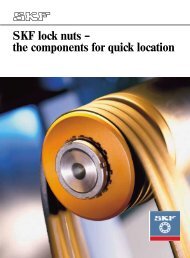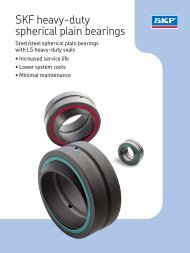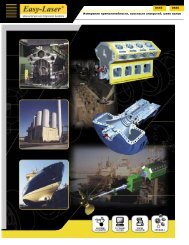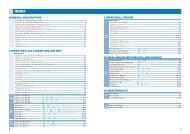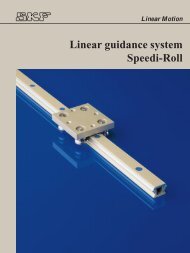Composite dry sliding bearings â maintenance-free and space-saving
Composite dry sliding bearings â maintenance-free and space-saving
Composite dry sliding bearings â maintenance-free and space-saving
You also want an ePaper? Increase the reach of your titles
YUMPU automatically turns print PDFs into web optimized ePapers that Google loves.
Application of <strong>bearings</strong>Design of associatedcomponentsBushingsThe surface of the shaft on which thebushing runs, i.e. the counterface,should always be wider than the actualbushing – particularly where axialdisplacement of the shaft relative tothe housing may occur as a result ofchanges in shaft length – in order toprevent step formation in the <strong>sliding</strong>surface.To ease mounting, shaft ends <strong>and</strong>housing bores should have a lead-inchamfer with an angle of 10 to 15°(➔ fig 1 ). It is then easier to press thebushings into the housing bore <strong>and</strong> toinsert the shaft into the bushing borewithout the risk of damaging the <strong>sliding</strong>surface.The housing shoulders intended foraxial location of the bushing shouldhave a diameter which is equal to orgreater than d + 0,8 mm.Where PTFE composite bushingsoperate without lubricant it is especiallyimportant to accurately align bearingpositions. If misalignment betweenthe positions cannot be avoided, it isnecessary to take steps at the designstage to prevent inadmissibly highedge stresses from occurring. Forexample, the housing bore seatingshould be relieved at both sides, or awider bushing should be used so thatit extends beyond the housing boreseating at both sides (➔ fig 2 ).If errors of alignment have to becompensated for <strong>and</strong> the operatingconditions permit the use of POM composite,then bushings of this materialshould be chosen. The covering layerof this material can be machined to aminimum degree after the bushing hasbeen mounted in a housing bore.Flanged bushings <strong>and</strong> thrustwashersFor shafts which not only need radialsupport, but also require axial location,flanged bushings or a combinationof bushing <strong>and</strong> thrust washer(➔ fig 3 ) can be used, depending onthe magnitude of the axial load. Theuse of flanged bushings or thrustwashers is advantageous even whereaxial loads are small, particularlywhere suitable surfaces are not availableto take the thrust, either becausethe material or its finish is unsuitable.It should be remembered that thecounterface should completely coverthe <strong>sliding</strong> surface of the thrust washer<strong>and</strong> the flange of a flanged bushing(➔ fig 4 ). For bearing arrangementswhere flanged bushings are used thetransition from housing bore to abutmentshould be chamfered so that itdoes not contact the bushing at thetransition to the flange (➔ fig 5 ).Thrust washers are generally locatedradially in a turned recess in thehousing (➔ fig 3 ) <strong>and</strong> secured by adowel pin or grub screw to preventthem from rotating. The appropriatedimensions for this type of location aregiven in the product tables. If a recesscannot be provided in the housing forsome reason, the thrust washer canbe attached to the housing by twopins or screws (➔ fig 6 ) or by glueing.The heads of the pins or screwsmust be recessed to at least 0,3 mmbelow the <strong>sliding</strong> surface <strong>and</strong> the entiresurface of the thrust washer mustbe supported.Lead-in chamfers for housing bores <strong>and</strong>shaft endsBushing extending beyond the <strong>bearings</strong>eating in the housing at both sides toprevent inadmissibly high edge stressesCombination of bushing <strong>and</strong> thrustwasherFig 1Fig 2Fig322


